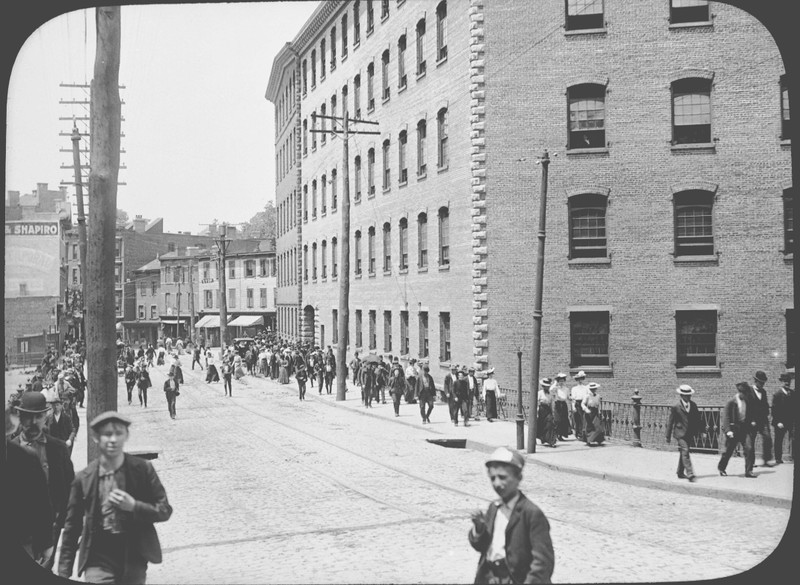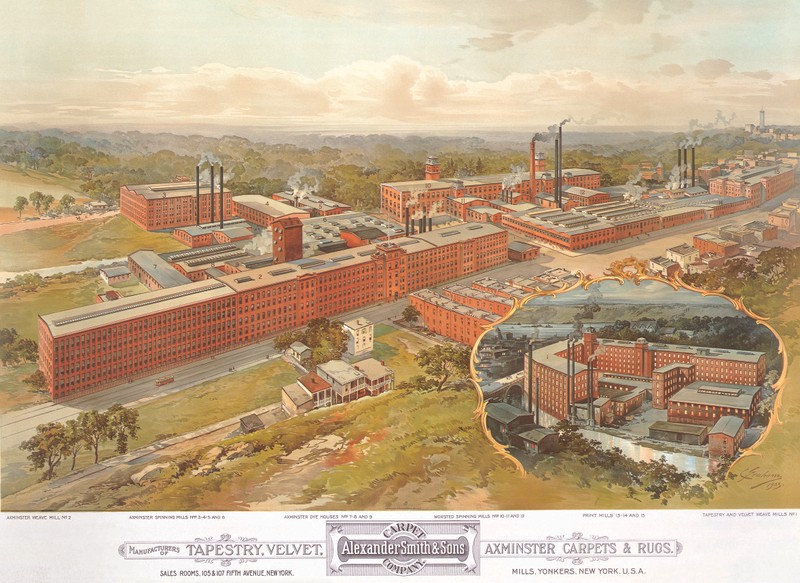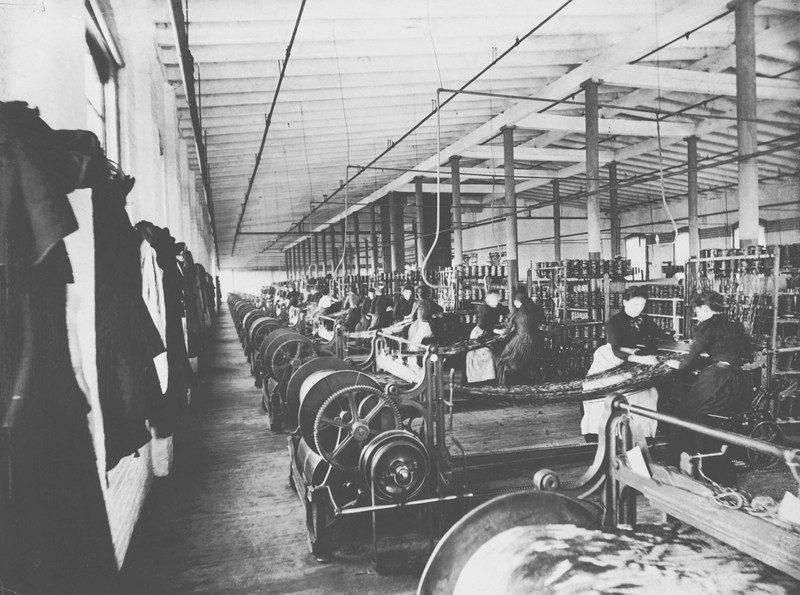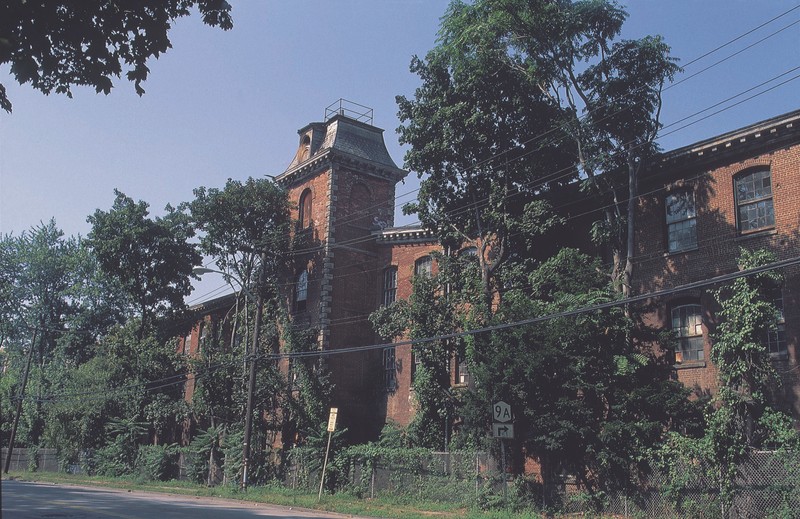Alexander Smith Carpet Mills Complex
Introduction
Text-to-speech Audio
Once the world’s largest carpet manufacturer, the Alexander Smith Carpet Mills complex included 19 buildings spread across 39 acres and employed 7,000 workers at the turn of the 20th century. The company’s technological innovations transformed the efficiency of carpet production and played a key role in influencing Yonkers’ growth as a city. The oldest existing building at the complex was completed in 1871. The stylistically varied complex has a cohesiveness both aesthetically and functionally. The major buildings display curved mansard roofs in the French Second Empire style, while the worker’s housing is contained in traditional row homes on the edge of the campus. Although the doors of “the carpet shop,” as it was known locally, closed in 1954, the buildings of the complex have been in use since 2015 as a New York State Qualified Production Facility (QPF) and film studio in the heart of Yonkers Carpet Mills Arts District. The complex was added to the National Register of Historic Places in 1983.
Images
Workers leaving the Palisade Avenue Factory

The Alexander Smith Carpet Mills Complex in 1903. Chromolithograph after C. Graham.

Workers inspecting finished carpets

Section of factory built in 1871

Backstory and Context
Text-to-speech Audio
Although factories for carpet production in the United States had been in existence as early as 1825, inventions at the Alexander Smith Carpet Mills significantly reduced the cost of making high quality carpets and allowed the company’s sales to flourish both in the United States and internationally. The Skinner-Smith Axminster loom of 1877, for example, was an improved version of the original loom for tufted, pile carpets. It replaced an 1856 model also created at the Yonkers complex, lowering the cost of carpet production by 75%.
Alexander Smith (1818-1878) was a businessman from Trenton, NJ, who had purchased his first carpet company in 1845 in West Farms, NY (then in Westchester, now in the Bronx). He lost that factory to a fire, along with the one he built to replace it, prompting his move in 1864 to Yonkers where Smith built his massive carpet complex; first as the “lower mills” and then expanding farther northward up the Saw Mill River to its current location. For over three decades, Smith was associated with Halcyon Skinner (1824-1900), a brilliant inventor, carpenter, and mechanic. The Axminster loom Skinner designed with Alexander Smith was the largest in the world until the looms for wall-to-wall carpeting were made.
In 1874 Alexander Smith made an unsuccessful bid for mayor of Yonkers. Four years later, however, he was elected as a Republican representative to the United States Congress. Sadly, he never took office, as he collapsed of a heart attack on election night.
The Alexander Smith Carpet Mills never shut down its production during the Great Depression and had only ceased making carpets for five months during the Panic of 1893. Over the years, workers had made several attempts to unionize in protest of oppressive working conditions. They were not successful until 1937 when Local 122 of the United Textiles Workers Union was formed. That year the union vote ballots were in English, Polish, and Slavic, reflecting Yonkers’ various immigrant communities.
In 1945, 1951, 1952, and 1954, Local 122 staged worker walkouts. After the last one, the Alexander Smith Carpet Mills closed the doors to its Yonkers location for good and moved to Greenville, Mississippi, which offered both tax advantages and nonunionized labor. By this time, wall-to-wall carpet had achieved more popularity in the United States than the traditional nine-foot looms of the Carpet Mills, and the market became flooded with imported rugs.
The complex sat vacant for only a few years before new businesses moved into the abandoned buildings of the complex. In 1978, Allan Eisenkraft, president of the Yonkers Industrial Development Corporation, purchased 150,000 square feet. Over the subsequent decades many artists and landlords acquired space in the complex, prompting the eventual Yonkers’ zoning change in 2016 that converted the Alexander Smith Carpet Mills to the Carpet Mills Arts District.
Sources
“Alexander Smith Carpet Mills #83001832.” National Register of Historic Places. Accessed Sept 18, 2021. https://npgallery.nps.gov/NRHP/GetAsset/122b0d01-eea5-4761-947f-2b0637f1e8cc
“Alexander Smith Carpet Mills.” Visit Westchester County, NY, website. April 29, 2015. Accessed Sept 18, 2021. https://www.visitwestchesterny.com/listing/alexander-smith-carpet-mills/596/
Golden, John. “Arts District Avant-Garde.” Westchester County Business Journal. Aug 25, 2014. Accessed Sept 18, 2021. https://issuu.com/thewagmag/docs/west_082514
“In the Mill: An Exhibition at the Hudson River Museum.” Promotional brochure. Aug 24 through Nov 13, 1983.
Kelly, Joe. “When the Mill Pulled the Rug Out From Under Yonkers.” New York Times. July 29, 1979. Accessed Sept 18, 2021. https://www.nytimes.com/1979/07/29/archives/westchester-weekly-when-the-mill-pulled-the-rub-out-from-under.html
Singer, Penny. “In Big Factory, Small Businesses Prosper.” New York Times. Aug. 26, 1990. Accessed Sept 18, 2021. https://www.nytimes.com/1990/08/26/nyregion/in-big-factory-small-businesses-prosper.html
Williams, Gray. Picturing Our Past: National Register Sites in Westchester County. Elmsford, NY: Westchester County Historical Society, 2003.
Wrightson, Karolyn. “Carpet Mill in Yonkers has Character.” Hindsights. May 11, 1996.
“Yonkers Mayor Spano Proposes Historic Alexander Smith Carpet Mills Site to be Designated as an Arts District.” Yonkers, NY, government website. Accessed Sept 18, 2021. https://www.yonkersny.gov/Home/Components/News/News/2509/3218
Yonkers Historical Society
The Hudson River Museum
Hudson River Museum
Gray Williams
